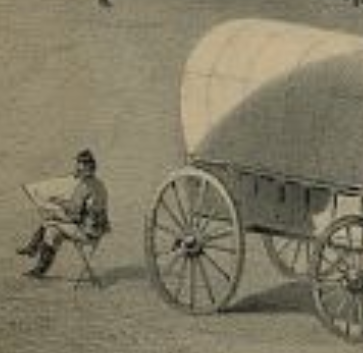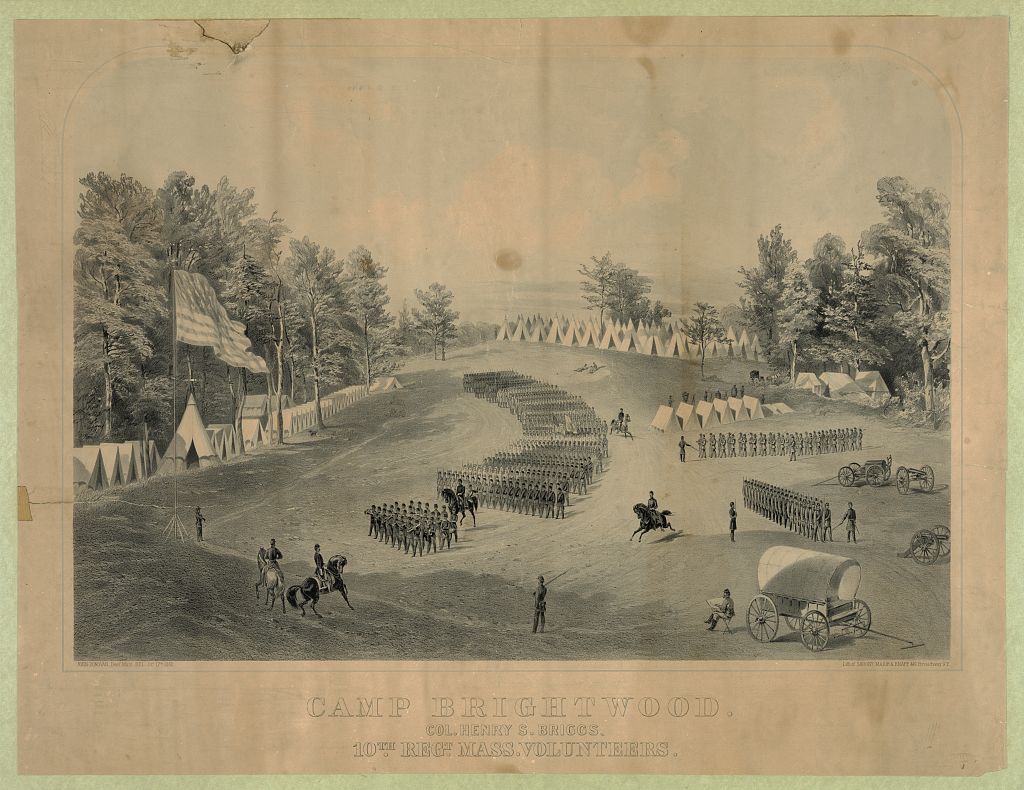
Soldiers march as a group, in a clearing surrounded by canvas tents and some horses and cannons. In the corner, an artist, Deaf soldier John Donovan sits by a wagon as he draws the scene.
- Donovan, J. (1861). “Camp Brightwood, Colonel Henry S. Briggs. 10th Regiment Massachusetts Volunteers. John Donovan, Deaf Mute, DEL Oct 17th 1861.” Library of Congress.
Early in the Civil War, defending Washington, D.C., was an urgent priority of the Lincoln Administration. To defend the nation’s capital, several forts were constructed around the city, including Fort Massachusetts, built during the first winter of the war by the 10th Massachusetts Volunteers, seen drilling in the lithograph of Camp Brightwood. The lithograph was the creation of the man seated in the lower right corner of the print. That man was John Donovan (1816-1864) of Lee, Massachusetts, and he was Deaf.
Donovan, a tailor by trade, had enlisted with the 10th Massachusetts in Springfield on July 24, 1861. As a deaf man, Donovan appears to have enlisted illegally. (The term used at the time was, “deaf-mute”.) Enlistees had to be examined by a physician, and men with disabilities, including deafness, were kept out of the Union Army. Nevertheless, Donovan joined the 10th and worked repairing clothing for the men of the regiment. He was also a skilled artist, and his sketch of Camp Brightwood earned the praise of Horace Greeley’s New York Tribune for, “his natural gift for drawing.” The newspaper went on, “An accurate draft of Camp Brightwood, made by him, is now in the hands of lithographers, and will shortly be issued. He is spoken of in the highest terms of praise by the officers of his regiment.”
The praise of his superiors, however, did not keep him in uniform. Apparently because of his unlawful enlistment, he was discharged and returned to his family in Massachusetts. He died around 1864.
Later in the war, manning the defenses of Washington became a primary mission of the Invalid Corps.
For more information on the defense of Washington by disabled soldiers, see the article on the Invalid Corps.
Sources:
- Brown, N.R. (2018). “Putting the Pieces Together – John Donovan, ‘Deaf-Mutes’ of the Massachusetts Volunteers.” Invalid Corps.
- Donovan, J. (1861). “Camp Brightwood, Colonel Henry S. Briggs. 10th Regiment Massachusetts Volunteers. John Donovan, Deaf Mute, DEL Oct 17th 1861.” Library of Congress.
- Roe, Alfred S. (1909). The Tenth Regiment, Massachusetts Volunteer Infantry, 1861-1864, a Western Massachusetts Regiment (Springfield, Mass.: Tenth Regiment Veteran Association).
- Valley Gleaner. February 20, 1862.
The clipping from The Valley Gleaner of Lee, Massachusetts reads:
- The following notice of Mr. John Donovan, a deaf mute who formerly resided in this town, is cut from the N.Y. Tribune: "Connected with the Springfield City Guard, Capt. Lombard, 10th Regiment Massachusetts Volunteers, now stationed at Camp Brightwood, Virginia, is a deaf mute named John Donovan, who is regularly enlisted as a soldier, and detailed as the regimental tailor. He learned the trade of tailor in Brooklyn. Some time since he went to Springfield, Mass., from which city he enlisted at the commencement of the rebellion. His infirmity, of course, precludes him from performing the ordinary duties of a soldier, and being employed as the regimental tailor, he has many [l - garbled] which he has improved by the practice of a natural gift for drawing. In this art he is a self-taught man, and the proficiency he has attained is truly astonishing. An accurate draft of Camp Brightwood, made by him, is now in the hands of lithographers, and will shortly be issued. He is spoken of in the highest terms of praise by the officers of his regiment.





